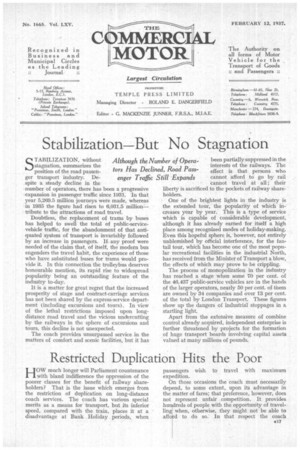Stabilization—But No Stagnation
Page 67

If you've noticed an error in this article please click here to report it so we can fix it.
STABILIZATION, without stagnation, summarizes the position of the road passenger transport industry. Despite a steady decline in the .number of operators, there has been a progressive . expansion in passenger traffic since 1931. In that year 5,269.5 million journeys were made, whereas in 1935 the figure had risen to 6,031.5 million-tribute to the attractions of road travel.
Doubtless, the replacement of trams by buses has helped to swell the total of public-servicevehicle traffic, for the abandonment of that antiquated system of transport is invariably followed by an increase in passengers. If any proof were needed of the claim that, of itself, the modern bus engenders the travel habit, the experience of those who have substituted buses for trams would provide it. In this connection the trolleybus deserves honourable mention, its rapid rise to widespread popularity being an outstanding feature of the industry to-day.
It is a matter for great regret that the increased prosperity of stage and contract-carriage services has not been shared by the express-service department (including excursions and tours). In view of the lethal restrictions imposed upon longdistance road travel and the vicious undercutting by the railways in the sphere of excursions and tours, this decline is not unexpected.
The coach provides unsurpassed service in the matters of comfort and scenic facilities, but it has been partially suppressed in the interests of the railways. The effect is that persons who cannot afford to go by rail cannot travel at all ; their liberty is sacrificed to the pockets of railway shareholders.
One of the brightest lights in the industry is the extended tour, the popularity of which in creases year by year. This is a type of service•which is capable of considerable development, although it has already earned for itself a high place among recognized modes of holiday-making. Even this hopeful sphere is, however, not entirely unblemished by official interference, for the fantail tour, which has become one of the most popular recreational facilities in the industrial North, has received from the Minister of Transport a blow, the effects of which may prove to he crippling.
The process of monopolization in the industry has reached a stage when some 70 per cent. of the 46,437 public-service vehicles are in the hands of the larger operators, nearly 50 per cent. of them are owned by 34 companies and over 13 per cent. of the total by London Transport. These figures show up the dangers of industrial stoppages in a startling light.
Apart from the extensive measure of combine control already acquired, independent enterprise is further threatened by projects for the formation of huge transport boards involving capital assets valued at many millions of pounds.




























































































































































